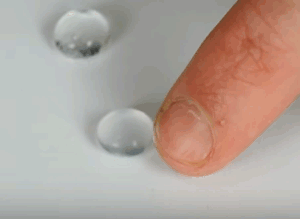tl;dr– Hydrophobic-water would be water that doesn't significantly cohere to itself. So, water's hydrophobic when it wouldn't form a condensed-phase (e.g., if it boils and preferentially exists as a gas at equilibrium). Can't have hydrophobic-water in an equilibrium-preferred condensed-phase, as a condensed-phase means that the material's sticking to itself and thus isn't phobic of itself.
Two species are phobic within some medium under some conditions when they don't here together (cohere if they're the same species; adhere otherwise).
To be clear: phobic species don't really repel so much as they're not very attracted to each other.
Species can become self-phobic. Of course, it's important to remember that members of the species aren't repulsing others of their own kind so much as just aren't very attracted to them. And then since they're not really attracted, they do the natural thing and just tend to disperse, filling the volume containing them. In other words, they vaporize.
Water can be vaporized, e.g. through heating.
Note: Can't have hydrophobic-water as a condensed-phase.
A condensed-phase (like liquid or solid) is defined, in part, by the material sticking to itself.
You can have hydrophobic-water physically inside of a condensed-phase, e.g. you can have molecular-water as a minority-component of a larger material-phase in a scenario in which the molecular-water wouldn't be so cohesive, but you can't have hydrophobic-water as a condensed-phase, because it wouldn't cohere (and thus wouldn't be condensed).

